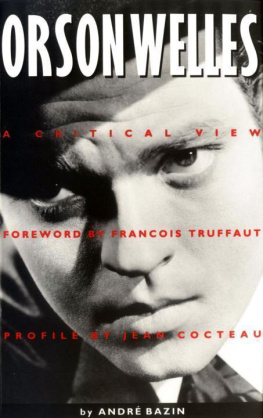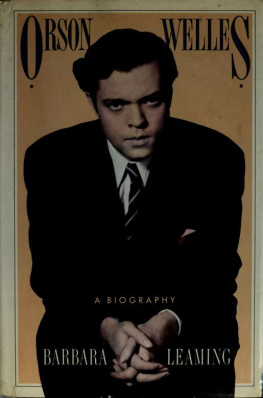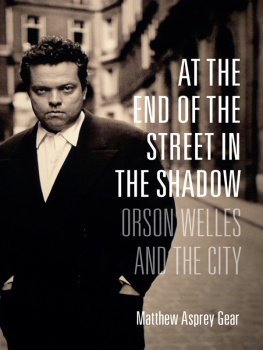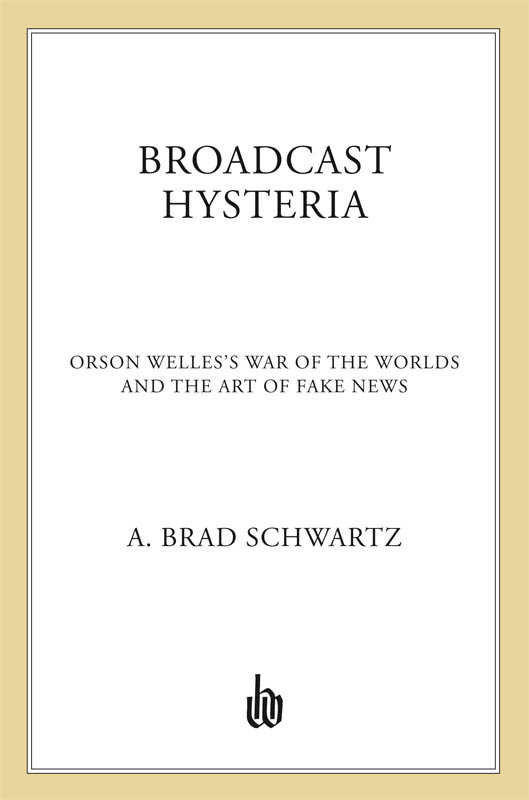Schwartz A. Brad - Broadcast hysteria : Orson Welless War of the worlds and the art of fake news
Here you can read online Schwartz A. Brad - Broadcast hysteria : Orson Welless War of the worlds and the art of fake news full text of the book (entire story) in english for free. Download pdf and epub, get meaning, cover and reviews about this ebook. City: New York, year: 2015, publisher: Macmillan;Hill and Wang, genre: Art. Description of the work, (preface) as well as reviews are available. Best literature library LitArk.com created for fans of good reading and offers a wide selection of genres:
Romance novel
Science fiction
Adventure
Detective
Science
History
Home and family
Prose
Art
Politics
Computer
Non-fiction
Religion
Business
Children
Humor
Choose a favorite category and find really read worthwhile books. Enjoy immersion in the world of imagination, feel the emotions of the characters or learn something new for yourself, make an fascinating discovery.

- Book:Broadcast hysteria : Orson Welless War of the worlds and the art of fake news
- Author:
- Publisher:Macmillan;Hill and Wang
- Genre:
- Year:2015
- City:New York
- Rating:3 / 5
- Favourites:Add to favourites
- Your mark:
Broadcast hysteria : Orson Welless War of the worlds and the art of fake news: summary, description and annotation
We offer to read an annotation, description, summary or preface (depends on what the author of the book "Broadcast hysteria : Orson Welless War of the worlds and the art of fake news" wrote himself). If you haven't found the necessary information about the book — write in the comments, we will try to find it.
On the evening of October 30, 1938, radio listeners across the United States heard a startling report of a meteor strike in the New Jersey countryside. With sirens blaring in the background, announcers in the field described mysterious creatures, terrifying war machines, and thick clouds of poison gas moving toward New York City. As the invading force approached Manhattan, some listeners sat transfixed, while others ran to alert neighbors or to call the police. Some even fled their homes. But the hair-raising broadcast was not a real news bulletin-it was Orson Welless adaptation of the H. G. Wells classic The War of the Worlds.
In Broadcast Hysteria, A. Brad Schwartz boldly retells the story of Welless famed radio play and its impact. Did it really spawn a wave of mass hysteria, as The New York Times reported? Schwartz is the first to examine the hundreds of letters sent to Orson Welles himself in the days after the broadcast, and his findings challenge the conventional wisdom. Few listeners believed an actual attack was under way. But even so, Schwartz shows that Welless broadcast became a major scandal, prompting a different kind of mass panic as Americans debated the bewitching power of the radio and the countrys vulnerability in a time of crisis. When the debate was over, American broadcasting had changed for good, but not for the better.
As Schwartz tells this story, we observe how an atmosphere of natural disaster and impending war permitted broadcasters to create shared live national experiences for the first time. We follow Orson Welless rise to fame and watch his manic energy and artistic genius at work in the plays hurried yet innovative production. And we trace the present-day popularity of fake news back to its source in Welless show and its many imitators. Schwartzs original research, gifted storytelling, and thoughtful analysis make Broadcast Hysteria a groundbreaking new look at a crucial but little-understood episode in American history.
Schwartz A. Brad: author's other books
Who wrote Broadcast hysteria : Orson Welless War of the worlds and the art of fake news? Find out the surname, the name of the author of the book and a list of all author's works by series.








